Level 2 EV charging has emerged as the dominant choice for EV charging with the growing popularity of electric vehicles (EVs) and the increasing need for reliable charging infrastructure, While Level 3 chargers, also known as DC Fast Chargers (DCFC), grab headlines for their rapid charging capabilities, L2 chargers remain the leading EV charger installations as they meet the daily charging needs of EV owners.
According to the Alternative Fuels Data Center, Level 2 charger installation in the United States is 79.5%, Level 1 EV charging is 2%, and Level 3 EV charging is 18.5%, as shown in the pie chart below.
The infographic image below compares Level 1, Level 2, and Level 3 charging. Level 1 chargers use a standard 120V AC outlet, while Level 2 chargers use a standard 240V single-phase electrical supply. At the same time, DCFC requires 480V three-phase power and additional permitting.
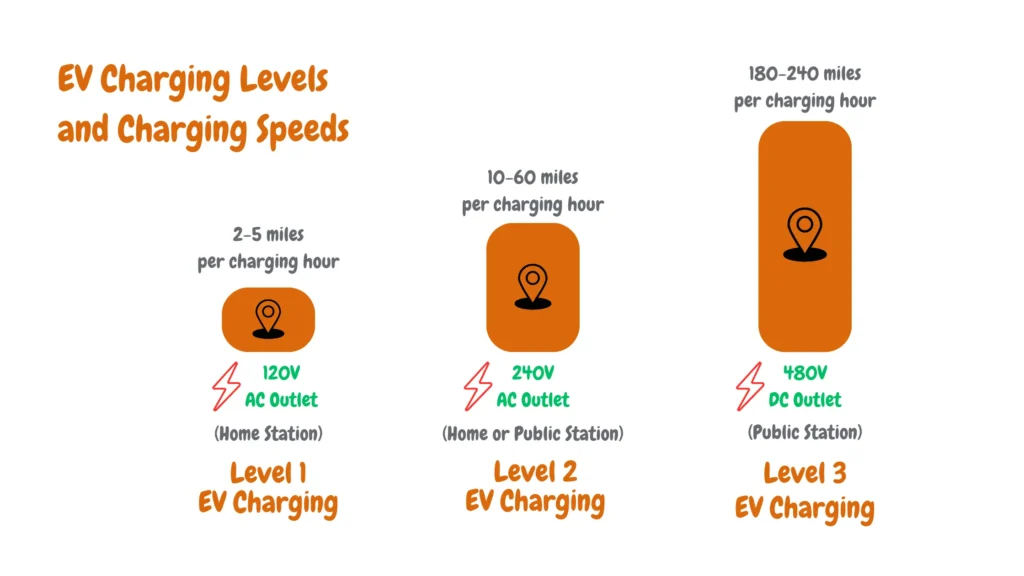
The main reason why Level 2 charger installations exceed other EV charging Levels is that Level 2 chargers can be installed practically everywhere.
Level 2 EV charging speeds of 10-60 miles per hour also align perfectly with Americans driving an average of 37 miles daily, according to Department of Transportation statistics.
Overall, Level 2 EV charging offers a good balance between speed, convenience, and cost, making it a popular choice for home and commercial charging.
There is a high demand for EV chargers, as we expect 26.4 million EVs on the US roads by 2030; it’s estimated that more than 30 million EV chargers will be needed by then to support the steady growth of EV adoption in the US. To meet the demand, businesses and EV owners opt for Level 2 EV chargers since they may already have the electrical infrastructure needed to install a Level 2 charger, making EV chargers’ connection to the grid even more cost-effective.
What is EV Level 2 Charging?
Level 2 EV charging is a step from the basic Level 1 charging that uses a standard household outlet. It offers significantly faster charging speeds, making it ideal for home and commercial use.
To quickly explain Level 2 EV charging, we have created descriptive infographics that highlight crucial Level 2 EV charging features such as power, speed, installation, and use, as shown below:

Here’s a breakdown of the EV Level 2 Charging critical features highlighted in the infographics.
EV Level 2 Charging Power and Speed
- EV Level 2 Charging Voltage: Operates at 208-240 volts, compared to Level 1’s 120 volts. This higher voltage translates to more power being delivered to your EV.
- EV Level 2 Charging Current: Delivers 12-80 amps, with 32 amps typical. Higher amperage means faster charging.
- EV Level 2 Charging Power Output: Ranges from 3 kW to 19.2 kW, with most common chargers being around 7-10 kW. This translates to adding 20-60 miles of range per hour of charging, significantly faster than Level 1’s 4 miles per hour.
- EV Level 2 Charging Time: Depending on your battery size and power, a Level 2 charger can fully charge your EV in 2-8 hours, much faster than Level 1’s 11-20 hours.
EV Level 2 Charging Installation and Use
- EV Level 2 Charging Outlet: Typically uses a NEMA 14-50 outlet, similar to a dryer outlet. However, it can also be hardwired for a more permanent installation.
- EV Level 2 Charging Connectors: Various connectors are used depending on the region and vehicle, including Mennekes (Type 2), Tesla, and GB/T (AC). Make sure your charger and car connector are compatible.
Comparing Level 2 EV Charging With Other EV Charging Levels.
Here’s a table comparison of Level 1, Level 2, and Level 3 EV charging:
| Feature | Level 1 | Level 2 | Level 3 |
|---|---|---|---|
| Charging Time | 6-22 hours | 2-8 hours | 30 minutes |
| Charging Speed | Adds 3-5 miles/hour | Adds 20-60 miles/hour | Adds 100-300 miles/hour |
| Power Requirements | Standard 120V Single Phase AC Power | 208-240V Single Phase AC Power | 480V, Three Phase AC Power |
| Power Output | 1.3 – 2.4 kW | 3 – 19.2 kW | 50 kW – 400 kW |
| Connector Types | J1772 (Type 1) | Mennekes (Type 2), Tesla, GB/T (AC) | CCS1, CCS2, CHAdeMO, GB/T (DC), Tesla |
| Amps | 12-16 amps | 12-80 amps | <125 amps |
| Charging Load | 1.4 – 1.9 kW | Typ. 7-10 kW | Typ. 50-150 kW |
| Application | Home | Home & Commercial | 480V, Three-Phase AC Power |
Level 2 strikes the perfect balance between speed, convenience, and cost. It’s powerful enough for most daily needs, readily available at homes and public stations, and won’t break the bank compared to DC fast-charging.
There is also a difference in EV charging processes when you compare Level 2 and Level 3 charging. For starters, level 2 AC occurs on the electric vehicle onboard charger, which means a Level 2 charger is a simple charger compared to a Level 3 charger, which includes an onboard charger in the charger itself that converts AC to DC. It’s able to transfer the DC directly to the vehicle’s battery, as shown in the infographic image below:

Level 2 Smart EV Charging Features
To illustrate Level 2 smart charging features, we have made an infographic that shows the concept of Level 2 smart features for EV charging in detail, including central hubs, communication networks, Grid connection, and Monitoring Features, and how they all connect to form one Smart EV charging environment.
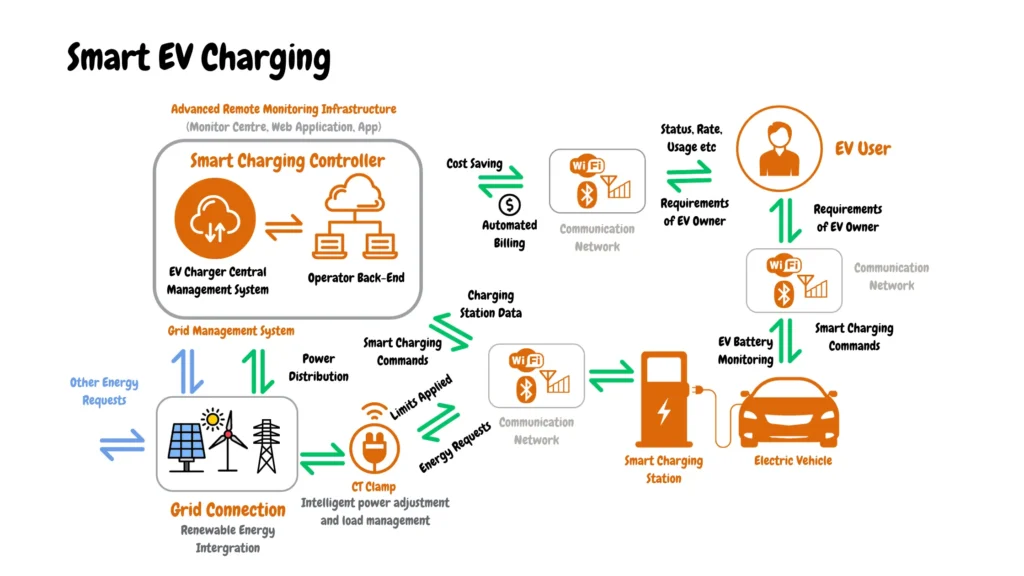
The specific features and functionalities of Level 2 smart charging systems can vary depending on the manufacturer and model. The infographic image above shows the main features and functionalities of high-end Level 2 EV chargers.
Specific features and functionalities of the Level 2 smart charging system:
Level 2 Smart EV Charging Central Hub
As shown in the infographic image above, the central hub of a smart level 2 EV charger consists of a smart charging controller operator backends and an EV charger central management system, which acts as the headquarters of a smart EV charging system.
- Smart Charging Controller: This brains the operation, managing charging based on various factors.
- Operator Back-End: Connects to the controller for remote management and data collection.
- EV Charger Central Management System: Oversees multiple charging stations and optimizes their performance.
Level 2 Smart EV Charging Communication Network
The infographics show that a Level 2 Smart EV Charging Communication Network has two main features: a network and EV smart charging data.
- Communication Network: A network (Wi-Fi, cellular, etc.) links the components for data exchange.
- Charging Station Data: Provides information on status, usage, power distribution, etc.
- Other energy requests: Integrates with smart home systems for energy management.
- Status, Rate, Usage, etc.: Provides detailed information on the charging process.
Level 2 Smart EV Charging Advanced Monitoring
There are two features shown related to the monitoring and management of charging stations, including:
- Monitor Centre, Web Application, App: Allow remote monitoring and management of charging stations.
- EV Battery Monitoring: Tracks battery health and optimizes charging for longevity.
- Intelligent power adjustment and load management: Automatically adjusts charging based on available grid capacity.
Benefits Level 2 Smart EV Charging
We recommend upgrading to a level 2 supported EV Charger, such as the Enphase Smart EV Charger, which offers benefits such as smart EV charging, cost savings, renewable energy integration, and automated billing.
Smart Grid Integration
- Grid optimization: Smart chargers can communicate with the grid to optimize charging based on various factors such as grid conditions, user preferences, and the availability of renewable energy. For example, they can adjust charging rates to avoid overloading the grid during peak hours or high electricity demand.
- User preferences: These chargers allow users to set preferences regarding charging times, ensuring that their vehicles are charged when it’s most convenient or cost-effective.
- Renewable energy availability: Smart chargers can prioritize charging when renewable energy sources like solar or wind power are abundant. This helps reduce reliance on fossil fuels and supports the transition to a cleaner energy grid.
Cost Saving
- Off-peak charging: By scheduling charging sessions during off-peak hours when electricity rates are lower, smart chargers can significantly reduce charging costs for EV owners.

- EV charging load management: Smart chargers can detect when renewable energy sources generate excess power and adjust charging accordingly. Charging during these times often incurs lower or even zero costs, further contributing to cost savings for EV owners.
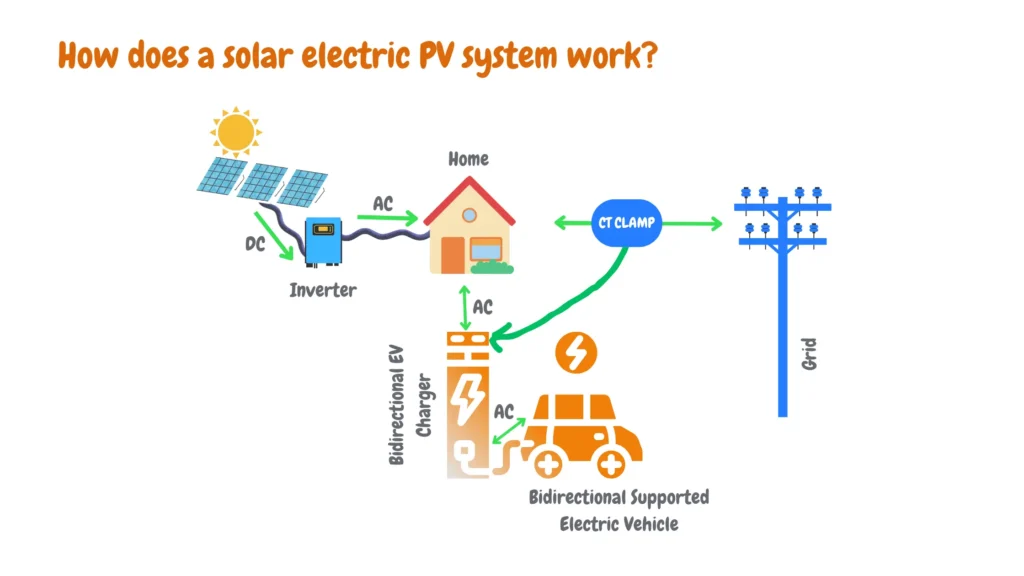
Renewable Energy Integration
Prioritizing renewable energy: Smart chargers can be programmed to prioritize charging using renewable energy whenever available. This reduces carbon emissions associated with EV charging and supports the growth of renewable energy infrastructure.
Automated Billing
Accurate billing: Smart chargers enable automated billing based on energy usage, providing EV owners with precise information about their charging costs. This eliminates the need for manual meter readings or estimations, ensuring fair and transparent billing practices.
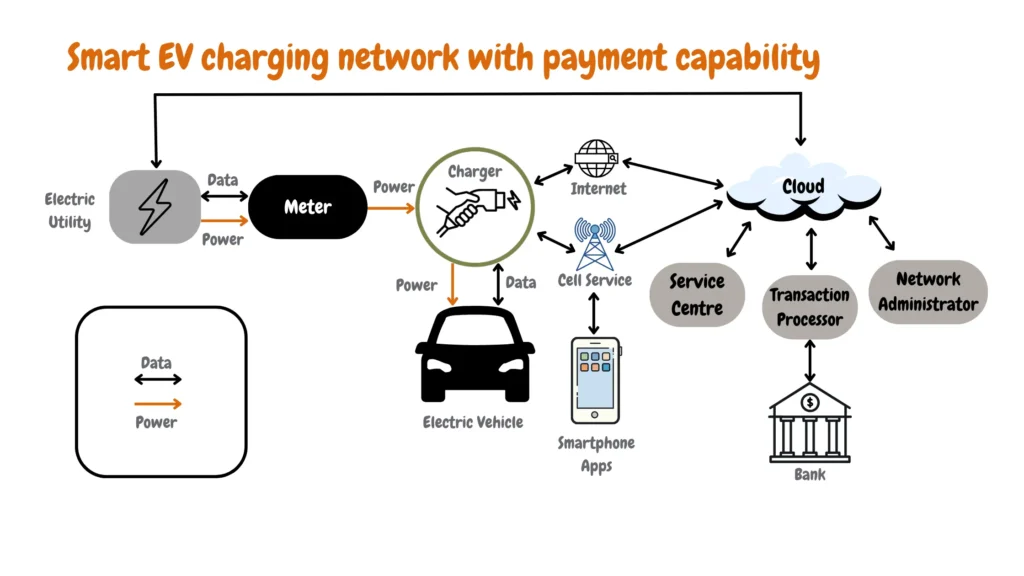
Installing Your Level 2 Charger
Ready to enhance your home with a Level 2 charger? Here’s how to make it happen efficiently and safely.
Choosing the Right Charger
Start by selecting a charger that is compatible with your EV and tailored to your charging needs. Consider your car’s recommended charging rate and connector type (such as SAE J1772 or Tesla’s proprietary connector) and your desired charging speed. Opt for a 6.2kW unit for standard needs or a 19.2kW charger for faster charging, keeping your budget and desired features in mind.
Assessing Your Electrical Panel
Most homes will need to upgrade their electrical panel to accommodate the increased power demand of a Level 2 charger. It’s crucial to have a qualified electrician assess your panel’s capacity and recommend any necessary upgrades.
Circuit Installation
A dedicated circuit breaker must be installed from your panel to the charging location. Depending on your home’s layout, this may involve running wires through walls or attics. Consider the complexity of the installation when budgeting for the project.
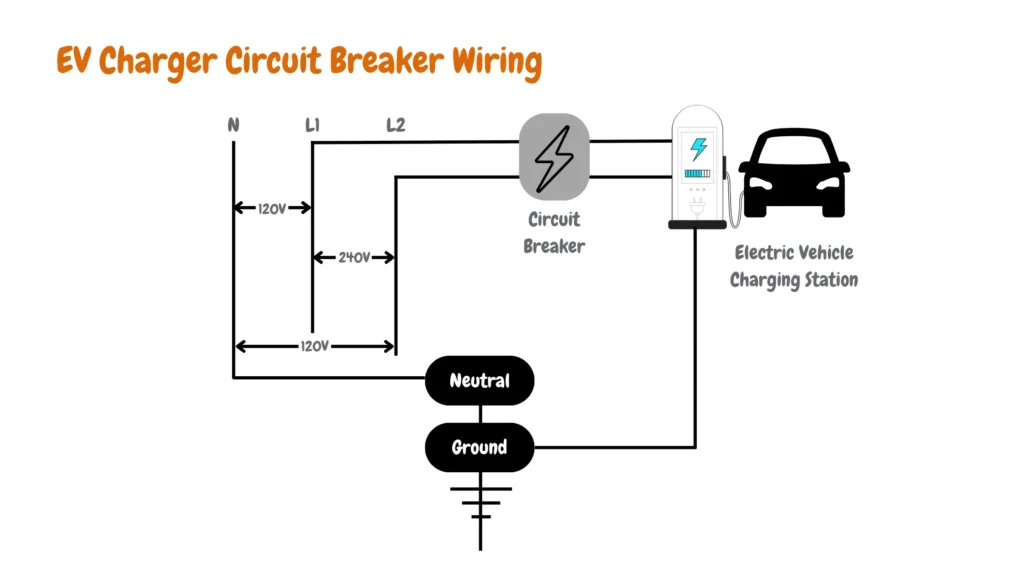
Permits and Incentives
Check local regulations for any permitting requirements related to EV charger installation. Additionally, explore federal and state-level incentives that can help offset installation costs. Research available programs in your area to maximize savings.
Public Level 2 Charging Options
There are lots of public Levels 2 chargers located in the United States for those who fear electric vehicles due to range and charging anxiety, you can use this EV Charging map on our website to find a vast EV charging stations network of public Level 2 chargers near you.
You will be able to filter Level 2 chargers by different EV charging network providers, such as Allego, BC Hydro EV, Blink, bp pulse, Chargefox, ChargeNet, ChargePoint, Circuit Electrique, Electrify America, Electrify Canada, EV Connect, EVgo, Evie Networks, EVUp, Fastned, FLO, GE WattStation, Greenlots, Ionity, IVY, myEVroute, OpConnect, Petro-Canada, SemaConnect, Sun Country, Supercharger, Tesla Destination, Volta and Webasto
To find the perfect pit stop, you can filter EV charger networks by connector type, availability, and real-time charging speeds.
Are Level 2 Public Chargers Good?
Public Level 2 chargers will not harm your electric vehicle or its battery. Public Level 2 chargers are just like the OEM Level 2 chargers you use at home, and the chargers are made under strict standardization protocols for interoperability purposes.
We love using Level 2 chargers located in workplaces, shopping centers and malls, parking garages, hotels, restaurants, and entertainment venues to replenish our EV batteries when we have range anxiety or when our EV will not be able to reach home in time before it runs out of battery power.
The good thing is that most public Level 2 chargers are smart, so there is no fumbling with cash or complicated payment systems since they are integrated seamlessly with mobile apps or RFID cards, allowing you to initiate and pay for charging sessions effortlessly. Some networks even offer subscription plans for frequent users, unlocking discounted rates and added convenience.
The Cost of Level 2 Charging
Investing in a Level 2 EV charger for your home, typically rated between 32-40A, typically ranges from $500 to $800 for the hardware alone. This initial investment covers the charger unit, any potential accessories, and installation costs to tailor your setup to your preferences and needs.
Alternatively, public Level 2 EV charging stations are more cost-effective than Level 3 chargers. In California, for instance, charging at a public Level 2 station typically costs around 30 cents per kWh, whereas utilizing a Level 3 charger can cost up to 40 cents per kWh, as illustrated in the accompanying bar graph.
Frequently Asked Questions (FAQs)
So, you’ve embarked on the exciting journey of Level 2 EV charging, and maybe a few questions have popped up along the way. Fear not, this FAQ section is here to address common queries and ensure you’re a charging pro in no time!
Level 2 Charging Times
How long does charging my specific EV with a Level 2 charger take?
Can I always leave my EV plugged in with a Level 2 charger?
Level 2 Charging Safety and Maintenance
Are home Level 2 charger installations safe?
How do I maintain my Level 2 charger?
Troubleshooting and Future Developments
What should I do if my Level 2 charger isn’t working?
What’s the future of Level 2 charging technology?
Conclusions
Upgrade to Level 2 charging for faster, more reliable power. This guide gives you the tools to make informed decisions and maximize your EV’s potential.
Understand your options, install safely, and utilize public stations efficiently. Stay informed about common issues and future tech. Don’t let slow charging or range anxiety hold you back. Research the best Level 2 chargers, especially based on smart features and emerging technologies, get installation quotes from different EV charger installers, and explore public EV charging options.

James Ndungu is a certified EV charger installer with over five years of experience in EVSE selection, permitting, and installation. He holds advanced credentials, including certification from the Electric Vehicle Infrastructure Training Program (EVITP) and specialized training in EV charging equipment and installation, as well as diplomas in EV Technology and Engineering Fundamentals of EVs. Since 2021, James has tested dozens of EV chargers and accessories, sharing expert insights into the latest EV charging technologies.
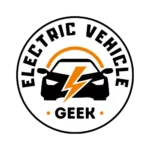







can you suggest a go between the electric outlet and charging cable that will measure KW usage so the condo management can charge me for my usage in my parking spot, hopefully not China made, many thanks.
I have written about the best smart meters for EV charging monitoring (most useful if you have integrated renewable energy EV charging) that connect to the electrical panel and require professional installation. Most smart plug meters available in the market such as Kill A Watt have limited current ratings (typically 10-15 amps) and can’t safely handle the higher loads of Level 2 EV chargers. I recommend using a plug-in smart EV charger, which is much cheaper, more functional, and versatile if you are using a dumb charger than purchasing and installing a smart energy meter just for EV charging monitoring.